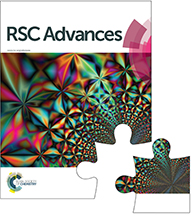Bis-indolylation of aldehydes and ketones using silica-supported FeCl3: molecular docking studies of bisindoles by targeting SARS-CoV-2 main protease binding sites†
Abstract
We report herein an operationally simple, efficient and versatile procedure for the synthesis of bis-indolylmethanes via the reaction of indoles with aldehydes or ketones in the presence of silica-supported ferric chloride under grindstone conditions. The prepared supported catalyst was characterized by SEM and EDX spectroscopy. The present protocol has several advantages such as shorter reaction time, high yield, avoidance of using harmful organic solvents during the reaction and tolerance of a wide range of functional groups. Molecular docking studies targeted toward the binding site of SARS-CoV-2 main protease (3CLpro or Mpro) enzymes were investigated with the synthesized bis-indoles. Our study revealed that some of the synthesized compounds have potentiality to inhibit the SARS-CoV-2 Mpro enzyme by interacting with key amino acid residues of the active sites via hydrophobic as well as hydrogen bonding interactions.



 Please wait while we load your content...
Please wait while we load your content...